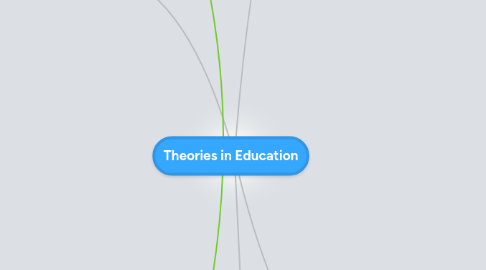
1. Education theories
1.1. Connectivism
1.1.1. Learning theory for the information age
1.1.2. Learning is a process of connecting information sources
1.1.3. Knowing where to find information is more important than actually knowing the information
1.1.3.1. (Use activities and projects that feature open ended internet research)
1.1.3.2. (Require students to practice using modern technological resources)
1.1.3.3. (Practise decision making by requiring students to determine what is relevant and what is not)
1.1.4. Learning takes into account perception and opinion
1.1.5. Knowledge exists in our communities, societies and resources, not necessarily in the learner
1.1.6. Making Connections is more important than building knowledge
1.2. Cognitive Load
1.2.1. Information processing theory focusing on working memory
1.2.2. Working memory capacity can handle 7 pieces of information at one time
1.2.3. Working memory separated into visual and phonetic processing centers
1.2.4. Overloading the working memory with too much information can inhibit learning
1.2.4.1. (Teachers must be careful not to load too much information on learners at once or learning might be inhibited)
1.2.4.2. (Stop to check for student understanding, ask questions)
1.2.4.3. (Ask students to demonstrate concepts using examples)
1.2.4.4. (Have students mentor eachother in small groups)
1.2.5. Working memory lasts between 30 seconds and 2 minutes
1.2.6. To retain information we must move information from working memory to Long term memory
1.2.7. Long term memory is infinite
1.2.8. Chunking related information can effectively expand the capacity of working memory
1.2.9. Lots of repetition assists complex learning
1.3. Constructivism
1.3.1. Knowledge is built from experience
1.3.2. New learning is built on a foundation of previous knowledge
1.3.3. Learners can modify their knowledge
1.3.4. Learning activities emphasize authentic and challenging work
1.3.4.1. (Use experiments and real world problem solving)
1.3.4.2. (Ask students: How is this activity helping your learning)
1.3.5. Human learning is constructed by learners
1.3.6. Learners are responsible for their own learning and performance
1.3.7. Teachers assist students in the construction of their knowledge rather than regurgitating a series of facts
2. Theory of Teachnology
2.1. Inspired by the structure of Philosophy of Teaching
2.2. Technology can be utilized to explore content or familiarize students with services, products and interfaces
2.2.1. (Or both at once)
2.3. Technology can be used to facilitate sharing between students using tech such as message boards
2.4. Focuses on the role of technology in the classroom
2.5. Online courses are one way that technology has been used in the classroom
2.6. Phoenix University
2.7. Our philosophy on technology and how it should be used in the classroom
3. Tech Theories
3.1. Media Ecology
3.1.1. Humans are affected by technology
3.1.2. Media as an environment
3.1.3. Lots of definitions
3.1.4. Focuses on our understanding of media, how it effects our perceptions of reality
3.1.5. Media = technology, books, radio, film, TV, codes and conventions to name a few
3.1.6. The study of these media environments includes a focus on structure, content and impact
3.1.7. It examines the roles that media supports and reproduces in our society
3.1.7.1. (As a class focus on the roles assigned to boys and girls and how they are portrayed in advertising, film and TV)
3.1.7.2. (Look at gender specific toys and what is expected of people in their youth, middle age and old age)
3.1.8. It examines how media is structured and why it makes us feel and act happy, angry, sad or indifferent
3.2. Social Construction of Technology
3.2.1. Technology is affected by humans
3.2.2. Technology is socially created because it fulfills the needs and desires of people within society
3.2.3. Technology will prevail or fail based on the judgements of the society for which it was created
3.2.4. SCOT is a theory and methodology
3.2.5. Analyze the causes that determine whether a technology is a failure or a success
3.2.5.1. (Ask students why the iPad is better than a traditional PC)
3.2.5.2. (Ask students why BLU Ray defeated HD DVD, the teacher can play devils advocate to encourage discussion)
3.2.6. Technology can only be understood if we understand the role it plays in society
3.2.6.1. (Show students a picture of a record, a garage door opener, and a farming thresher. Ask students to identify what each object is and what it does)
3.2.6.2. (Show students the Chinese page for Renren (The Chinese Facebook) and ask them what it is, how it is used and then compare with the ever familiar Facebook)
